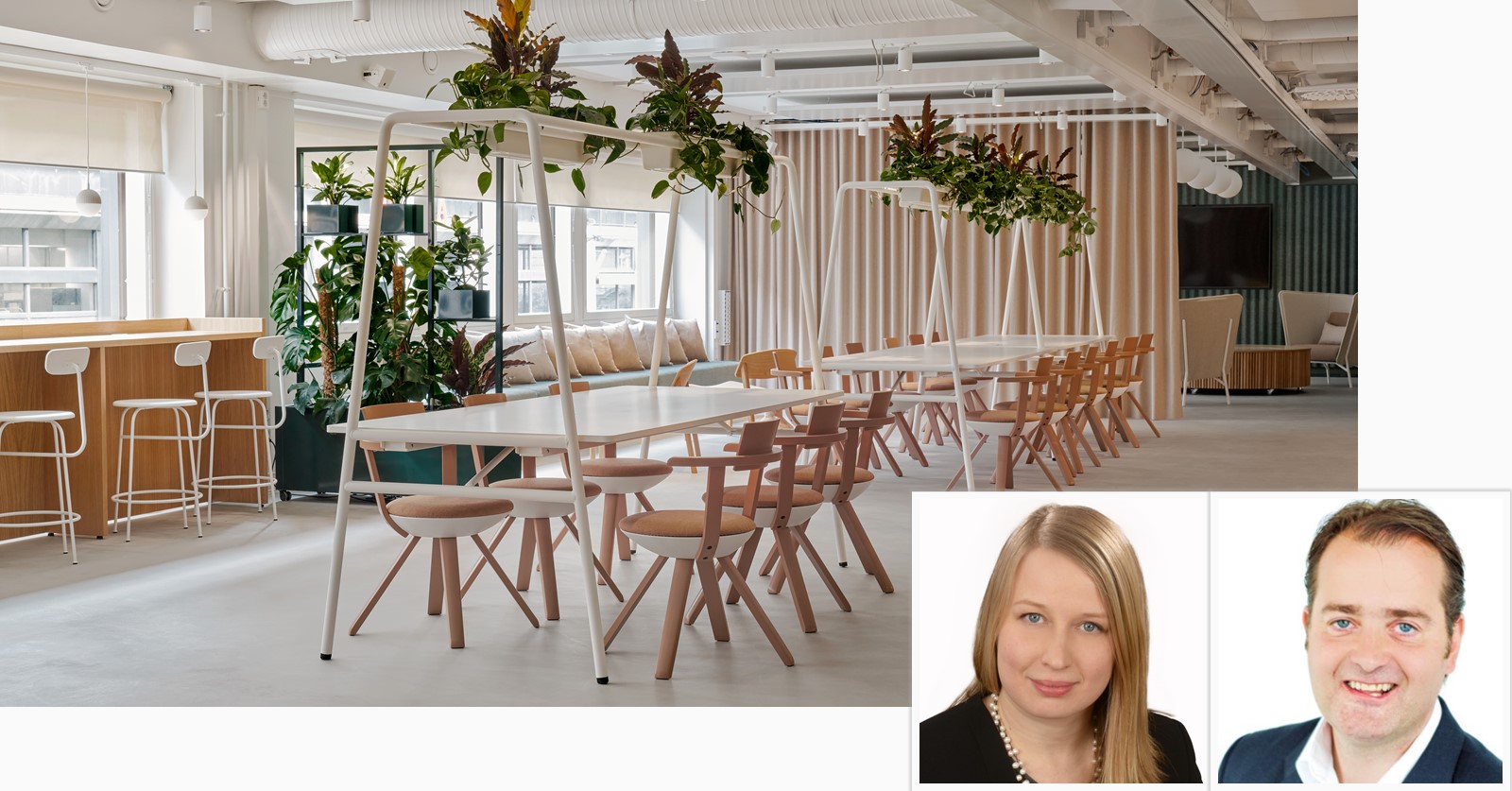The COVID-19 pandemic has disrupted both our daily and working livelihoods, and it is likely to continue to do so in the foreseeable future. Work life has become increasingly flexible in response to the pandemic, and employees have been given more freedom to choose when and where they wish to work from. It seems unlikely that we would see the return of sitting at your designated desk from 08:00-16:00.
Read the article by CBRE´s experts Einar Schiefloe and Susanna Heino from Occupier Services to find out, how offices will adapt to post COVID-19 reality.
The variety of zones
Over the past decade there has been a clear trend towards greater workplace flexibility. Employers are starting to provide an increased variety of space types that employees can leverage to complete tasks more effectively e.g. library areas for concentration and open and innovative spaces for collaboration. Interestingly, before the outbreak of COVID-19, companies had already been reporting that they were making workplace changes in response to social changes and technological advances.
In addition to increased flexibility for employees, the change also enables companies to implement a more fit-for purpose real estate portfolio and develop a unique cultural DNA to help to attract talents.
Hybrid as the new norm
There should be a balance between flexibility and work mode stability in the office, and that´s why it is important to think strategically; what is the right space configuration and how should it be used and maintained?
Social relationships, communication, business development, motivation, inspiration, and knowledge sharing are aspects that need to be enabled and supported in the best possible way. There will be a push and pull between working from home and at the office, and all organizations must find the optimal balance to support efficient working processes and secure employee engagement. According to CBRE¹, the hybrid models enabled by technology will become the norm.
We do see that some companies have stated they will reduce space significantly, and others like Amazon have come to a different conclusion – increasing space above and beyond underlying growth in the hope that employees wish to return to the office (The Sunday Times, 22nd August).
It will be exciting to see the different approaches that companies take going forward.
The Nordics as early adapters
As said, COVID-19 has accelerated the trends of an already changing work environment. Here in the Nordics, we have been spearheading the move towards trusting employees to make her/his own choices when it comes to how and where they wish to work. Technology has facilitated this process and allowed us to quickly transform our homes into remote offices.
Although the overnight switch to remote working has not been an easy task for anyone, the Nordics have been early adopters of remote working policies. This may have given us a slight edge when implementing remote working best practices/new workplace policies in comparison to our colleagues around the globe, and thus giving a comparative competitive edge.
Trust, freedom and flexibility
CBRE’s Global Outlook 2030 report² (March 2020) identified that a significant number of employees had already been increasing the amount they worked remotely before COVID-19. CBRE’s The Future of the office: 2020 Global occupier sentiment survey³ (July 2020) highlights that this remote working trend is accelerating, and it is therefore likely to have a major impact on the real estate strategies of our occupiers going forward.
The survey also indicates that the respondent company employees are likely to be given more freedom when choosing the location from which they perform tasks post COVID-19. 25% of respondents indicated that their employees could choose to work remotely full-time in the future, and 61% indicated that they will offer their employees a hybrid arrangement whereby employees can choose whether they come to the office, stay at home or work from a satellite office or co-working facility.
This signalizes that employers are beginning to place more trust in their employees by increasing working flexibility. As productivity levels seem to have remained stable, this demonstrates that remote working is likely to become a more integral part of a companies’ working practices.
The challenge
Although remote working has proven successful, there are also some significant disadvantages in terms of creating and strengthening company culture. In addition, decreased social interaction, networking, mentoring, and collaboration as well as possibly a more stressed work-life balance which can also affect career growth and organizational productivity. Research suggests that the following areas must be carefully considered to reflect the new hybrid way of working: i) office design, ii) service offerings and iii) supporting technology. As an employee´s freedom of choice increases, the flexibility of office space must adapt accordingly.
Shared-space model = Cost savings
The occupier sentiment survey also demonstrates that as more employees adopt a hybrid way of working, a meaningful way to increase space utilization and efficiency for employers is to use a shared-space model to optimize occupancy rates in the office space with fewer employees working there on a daily basis. This translates into rent and operating cost savings that can be reinvested into improved space standards, enabling technology and enhanced employee services.
Conclusion
The future office will have a more significant role as a place for employees to collaborate, innovate and learn. The office will also serve as a key tool for employers to engage and attract talent, and to reflect the company’s brand, and culture. In addition, the function of the office has transformed from a traditional working environment to a place that fulfills social needs and creates a sense of belonging for employees.
It will be important for employers to consider this trend and make suitable changes to ensure that they are able to attract the best talent in the future.
Finding the balance will be the challenge!
Need help with updating your workplace strategy? Don´t hesitate to contact Einar or Susanna.
Links to CBRE source articles and reports:
1) The Hybrid Office: merging the physical and digital
2) Global Outlook 2030
3) The Future of the office: 2020 Global occupier sentiment survey

